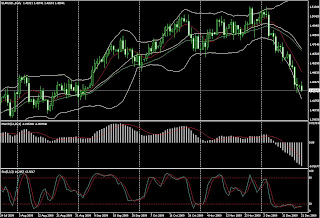I think it's quite possible.
The time of this breakage is questionable though. But all the ingredients seem to be in place. The government officials speak more often about a stronger dollar. The last Bernanke remarks are just in line. About half a month ago the president Obama spoke on a
meeting with an advisory board about the fact that America has to find a way to sustain growth without so much debt. Last week US Treasury Secretary spoke about the same
strong dollar topic in Japan.
But the officials are just the surface, I believe. They prepare the public and the markets. The real reasons could be drilled down to a simple "
demand & supply".
The more quantity you have of something, the more cheaper it is. With all those trillions of Dollars poured into the system (mainly as M1 money! which means the real amount of money expected to reach the public is multiplied by some figure) it's no suprise the dollar is cheap. Yes, there are more complicated connections in the market but the bottom line stays the same. Remember the times when Central banks occasionally were starting to buy their own currencies in order to lift their price? Things might have not changed so much...
There are at least two ways to decrease the supply of dollars - increasing the base interest rate of FED and getting back at least a part of the dollars put in the system. Leave aside all the demand for dollars that might be generated from the market.
For the last several years the stronger the dollar went, the lower the US stocks fell. This has something to do with the notion that the cheaper the dollar is, the more U.S. export there is and that stimulates the U.S. companies. But this might no longer be the case. Because no matter how cheap you sell, you have to sell to anyone. And when the world demand simply vanished, the cheaper you sell, the more you lose.
Add to this the prices of oil which closely reflects the movement of the dollar. Since
March 2009 the dollar has lost about 18% of its value against the Euro. The
crude oil more than doubled for the same period. This could be one of the main reason why the US officials want a stronger dollar. No matter how big are their oil companies and how much they export, they can't fill the gap and the damage the high oil price does to the America's economy.
The macro needs seem to come first and before the needs of the financial system now. Especially when that system is sort of stabilized. That explains all the talks about alternative energy sources and the eco economy. But to develop such economy takes time. The one thing that could give America the needed time happens to be a stronger dollar. Yes, maybe most of the near-time future profits of export oriented companies (which happens to be most of the big companies on U.S. stock exchanges) will suffer a decrease but this could be a sacrifice needed.
The last point is when the stocks and the dollar start to move more or less in the same direction. Or at least in not so heavy negative correlation. Aroung and above zero could be the best :) But this seems to be a tough task. It will take time for sure.
 The highest levels of Ford stock price were achieved during 1999-2000 while for the majority of other stocks the highest levels occured before the last bump at 2007. What I see interesting at this graph is that now the price is on an important level - the one that played resistance twice back at 1988-1990 and again at 2007-2008. There lies the Moving average (100) too.
The highest levels of Ford stock price were achieved during 1999-2000 while for the majority of other stocks the highest levels occured before the last bump at 2007. What I see interesting at this graph is that now the price is on an important level - the one that played resistance twice back at 1988-1990 and again at 2007-2008. There lies the Moving average (100) too. On the weekly graph we see the price making new highs while the MACD fails to make such. The Stochastic is in its overbought area but still hasn't turned down. So there might be some more time for goind up but the MACD divergence should be weighting even more. This view is supported by the fact that on the daily graph the situation looks pretty the same.
On the weekly graph we see the price making new highs while the MACD fails to make such. The Stochastic is in its overbought area but still hasn't turned down. So there might be some more time for goind up but the MACD divergence should be weighting even more. This view is supported by the fact that on the daily graph the situation looks pretty the same. 














